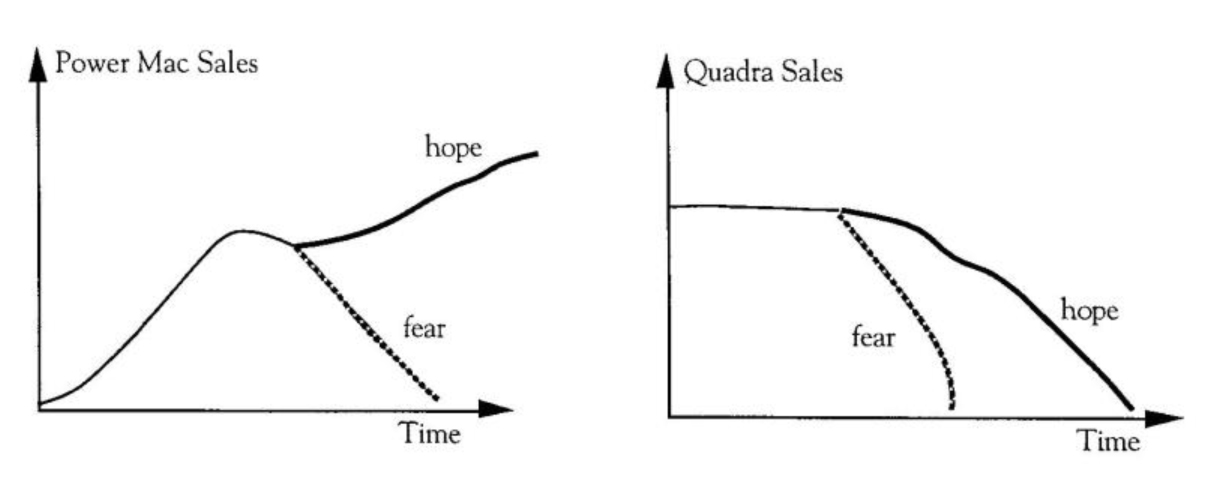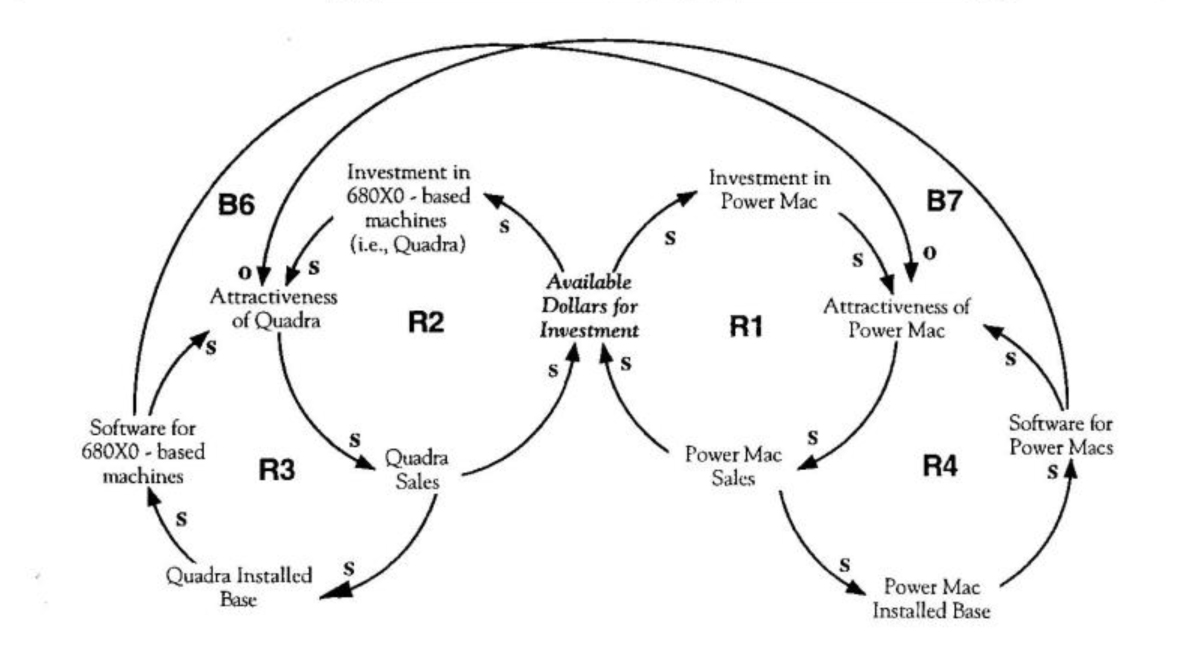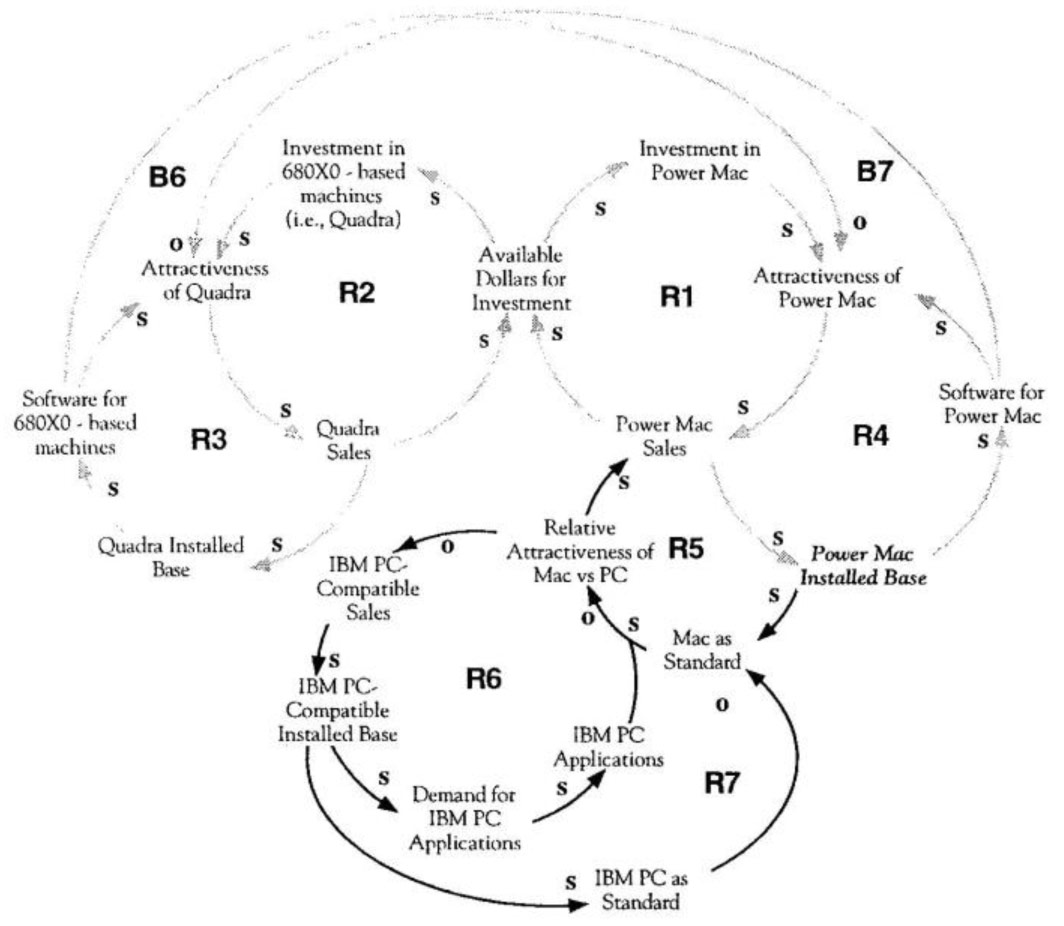One of the most delicate balancing acts a company must perform is to introduce a new product without cannibalizing or adversely affecting its existing products. Such is the dilemma currently facing Apple Computer.
The Power Mac, Apple’s latest addition to its line of Macintosh computers, abandons Motorola’s 680X0 microprocessor series for the faster, cheaper Power PC microprocessor. Although Apple hopes its Power Mac line will compete against IBM PC-compatibles from companies such as IBM, Compaq, and Dell, it is possible that a large fraction of Power Mac sales could come at the expense of its own 680X0-based Mac, the Quadra (“Apple Stews Over Emulator,” PC Week, June 13, 1994).
Ordinarily, the Quadra would enjoy one iron-clad advantage over the Power Mac: word processors, spreadsheets, and other programs written for the Quadra can’t run on the Power Mac under usual circumstances. Although the two machines look similar and share the same operating system, they are different inside. So, Apple created a program called an emulator, which “fools” the old word processors and spreadsheets into thinking that a Power Mac is a Quadra.
Emulation is slow, because the emulator has to translate every instruction from “Quadraeze” into “Power Maceze,” but it works. And the hope is that having thousands of programs running on the Power Mac albeit slowly — will get people to buy Power Macs. If the ranks of Power Mac users grow quickly, then software developers will begin to create software especially for the Power Mac. The new software programs, “native” to the Power Mac, will not run on the Quadra, but they will be faster than the old software ever was on the Quadra, and probably faster than similar programs written for IBM PC-compatibles.
The Dilemma
Now Apple has developed, but not yet introduced, a newer version of the emulator, which runs at twice the speed of its predecessor. Here is Apple’s dilemma: The faster the emulation, the more Power Macs in the world, so the more attractive Power Macs are to software developers. Unfortunately, the more attractive Power Macs are, the less attractive the old Quadras are.
If the Power Mac is too attractive too soon relative to the Quadra, sales of Quadras could collapse, leaving Apple with thousands of unwanted machines and millions of dollars in losses (see “Apple’s Fears and Hopes”). On the other hand, if the Power Mac is not attractive enough, then its sales will stall and software developers will never write the native applications that will realize the true potential of the Power Mac and make it competitive with IBM PC-compatibles.
Should Apple release the new, faster emulator, virtually assuring the success of the Power Mac but running an increased risk of having huge losses from unsaleable Quadras? Or, should Apple temporarily hold back on the new emulator to give the Quadra a fighting chance, but run the risk that the Power Mac will flop?
Discussion Questions
- How does Apple’s situation look if mapped from a “Balancing Two Boats” structure? (See Toolbox, p. 7.)
- What are the “cross-currents” — the unintended side-effects that success in one computer line has on the other?
- The Quadra vs. Power Mac dynamic is all the more dramatic because it is being played out against the back-drop of a larger “Success to the Successful” dynamic. What is the larger set of loops that Apple faces as a company?
- How can you begin to see and assess ways your own organization deals with similar archetypal dynamics?
Apple's Fears and Hopes

Discussion
Computer lines compete with each other both for customers and for software applications. Customers care about the speed of the computer, but their purchasing decision is also based on the available software. Can they get the word processors, spreadsheets, data-bases, and (most importantly) systems thinking software they want? Will they get upgrades fast? Will bugs be fixed quickly in interim releases?
Software vendors — Microsoft, Lotus, Claris, and others — do not have infinite resources; they need to focus their development efforts. They decide to develop programs based on the number of owners of a particular computer. If a type of computer has too few customers, software applications may dry up (i.e., no upgrades), or may never be written in the first place.
Therefore, a line of computers, its customers, and its software vendors are linked in several reinforcing loops: The more attractive a line of computers, the more machines will sell. The more machines sold, the greater the profit potential, and, therefore, the more applications for that machine will be developed, which increases its attractiveness.
Apple’s dilemma is that the reinforcing success loops for the Quadra and Power Mac are linked — more resources devoted to Quadra development means less devoted to the Power Mac. As investments are made in Power Macs, Apple’s revenues increase, permitting even further development efforts (loop RI in “Success of Quadra vs. Power Mac”). The same is true with investments in Quadras (R2).
As the Power Mac sales increase, the Power Mac becomes increasingly popular to software developers. Once they begin developing software for it, the Power Mac becomes even more attractive (R4). Unfortunately, as software is developed for the Power Mac, the Quadra becomes less attractive relative to the Power Mac. Furthermore, software development resources devoted to the Power Mac are resources that are not devoted to the Quadra. If this dynamic happens fast enough, Quadra sales can plummet, reducing profits and making it harder for Apple to invest in the Power Mac (B7). The same dynamic occurs if Quadra sales increase (R3) — in this scenario, though, development resources dry up for the Power Mac and it never takes off (B6 and R4).
Success of Quadra vs. Power Mac

As in any “Balancing Two Boats” dynamic, Apple must carefully manage the shift from Quadras to Power Macs. It wants to eventually phase out the Quadra and the 680X0 microprocessor, but it can’t easily afford a substantial decrease in Quadra sales while it still has inventory and manufacturing devoted to the line.
The Emulator Dilemma—First Pass
The “Balancing Two Boats” dynamic makes the emulator dilemma clearer. The emulator essentially changes the polarity of the link between “Software for 680X0-based Machines” and “Attractiveness of the Power Mac.” Now, the more software there is for the Quadra, the more attractive the Power Mac becomes (because with the emulator, those same programs can run faster on the Power Mac). The new emulator therefore increases the possibility that the Quadra will sink.
If Apple had the luxury of thinking only about balancing two boats, the analysis thus far would favor holding back on the new emulator, at least until the Power Mac becomes established enough that Apple can afford to let Quadra sales sink. However, the Power Mac vs. Quadra drama is taking place on a larger stage, in which there is not only the “Balancing Two Boats” dynamic, but also a “Success to the Successful” dynamic, which has far greater implications for Apple’s future (see “Apple-IBM ‘Success to the Successful’ “).
A “Success to the Successful” archetype involves two linked, self-reinforcing loops that share or compete for a common resource. Like two monkeys squabbling over food, if one wins, it puts on a little weight and adds some muscle, and has a greater chance of winning the next time. The losing player becomes a little smaller and weaker and has less chance of getting the next banana.
Unfortunately for Apple, the other primate looking for food is not just another monkey — it’s a 500-pound gorilla, and it wants to eat an Apple. The gorilla, of course, is the IBM PC-compatible computer architecture. The issue of whether Power Macs will cannibalize Quadras pales in relation to a more fundamental question: Can the Power Mac maintain and strengthen the tenuous hold the Mac operating system has in the wider world of personal computers?
Macintoshes currently hold a scant 10% of the personal computer market. By and large, Apple has been on the losing end of the “Success to the Successful” dynamic (loops R6 and R7 have dominated R5 and R4). The logical conclusion of this “Success to the Successful” dynamic would be the elimination of the Mac. That hasn’t happened, however, because the Macintosh has earned a small but loyal following due to its easy-to-use graphical operating system. Although the Macintosh line historically has been priced higher than other PCs and has run more slowly, its superior operating system has been worth it for some buyers.
The situation changed dramatically, however, when Microsoft introduced the Windows operating system for IBM PC-compatibles. The current version of Windows significantly narrows the ease-of-use advantage that Apple has enjoyed. By this time next year, Microsoft will have introduced a new version, Windows 95, which may well eliminate the gap entirely — and perhaps put IBM PC-compatibles in the lead for easy-to-use interfaces.
With Microsoft closing the operating system gap, Apple’s hope for staying in the race is to shift the basis of competition. The Power-PC chip in the new Power Mac offers such an option. It is faster and cheaper than the Intel chips that go into IBM PC-compatibles, which means that for the first time, Apple can offer computers that are faster than the competition at a lower price. The speed/price potential is a long-term benefit, but may not be enough to overcome the competition’s advantage of prior success.
Until Windows 95 hits the market, Apple still holds the lead in graphical user interface. With that, Apple has three of four requisites for challenging the dominance of IBM PC-compatibles: microprocessor speed, price, and ease of use. The fourth piece of the puzzle is native applications for the Power Mac. Without native applications, the full speed of the microprocessor cannot be realized. Although the Power Mac may outperform the Quadra with the new emulator, it is still not faster than the competition. Native applications are key to future success.
The Emulator—Take Two
Looking at loops R4 and R5, it may seem that Apple’s best strategy is to increase the attractiveness of the Power Mac so that sales increase to the point that developers will be willing to write native applications. From this vantage point, releasing the newer emulator is necessary to enhance the Power Mac’s attractiveness.
But the emulator is a strange attractor. It makes the Power Mac attractive because it can run the old Quadra software faster. But if the old Quadra software runs faster than it ever has on the Power Mac, will buyers — initially, people who already use Macs and already have software — spend money on an upgrade to native Power Mac versions of their favorite software? Maybe not, or at least not in the short run. So the emulator actually weakens or delays the development of native software for the Power Mac.
This is just the link that Apple relies on in order to make Power Macs competitive with IBM PC-compatibles, and Apple can’t afford for this link to be either weakened or delayed with Windows 95 on the horizon. It would appear, then, that Apple should not introduce the new emulator. Instead, they should spend their energies on enhancing Power Mac sales and encouraging Power Mac customers to demand native applications. In the short term, the emulator might appear to be a strong strategy. However, in the larger war against the IBM PC-compatibles, developing native applications for the Power PC is critical to Apple’s long-term success.
Author’s Note: Since the time the emulator story broke in PC Week and the ideas expressed here were developed, five months have passed. In that time, Apple has not introduced the new emulator, and Quadra sales have held up. There are now over 200 native Power Mac applications on the market. Industry observers, who a few months ago were predicting the end of Apple, are now entertaining the idea that Apple may survive and may even break out of its 10% niche. Windows 95 will ship in about 6 months.
Apple/IBM 'Success to the Successful'

Apple’s “Balancing Two Boats” dynamic is taking place within a larger “Success to the Successful” story . If Apple increases the installed base of Power Mac users and encourages “native” Power Mac applications, it could increase the Mac’s attractiveness relative to IBM PC-compatibles and make substantial inroads in making Macintosh computers the standard (R5). On the other hand, if IBM PC-compatibles retain their speed and price advantage over the Mac, demand for PCs and PC software will grow (R6), decreasing the Mac’s attractiveness (R7).
